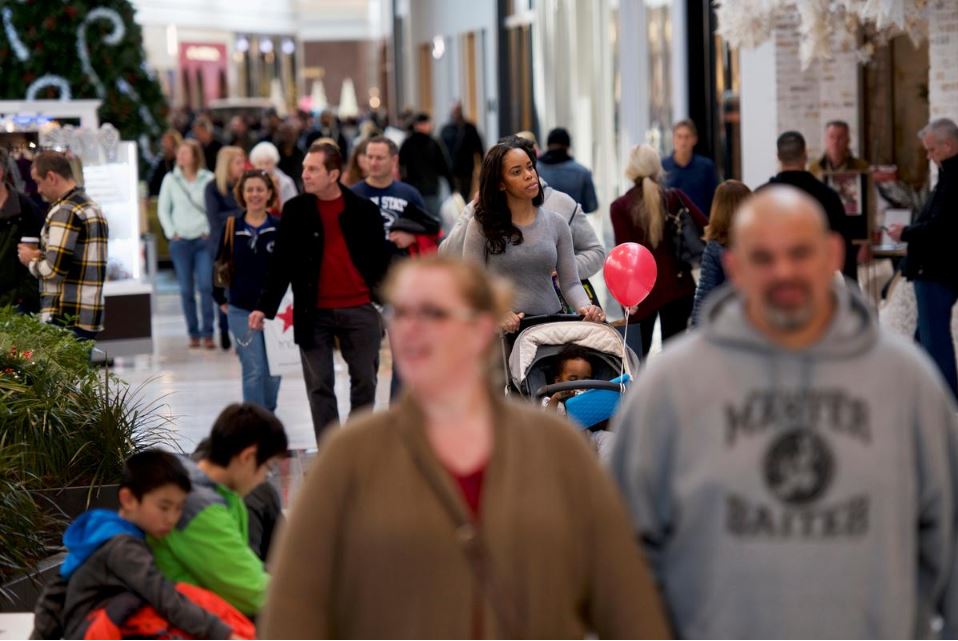FILE PHOTO: Shoppers walk through the King of Prussia Mall, United States’ largest retail shopping space, in King of Prussia, Pennsylvania, U.S., December 8, 2018. REUTERS/Mark Makela
Lucia Mutikani
Source: www.reuters.com, December 201
WASHINGTON (Reuters) – U.S. retail sales increased less than expected in November as Americans cut back on discretionary spending despite a strong labor market, raising fears the economy was slowing a bit faster than anticipated in the fourth quarter.
The report from the Commerce Department on Friday bucked a recent raft of fairly upbeat data on the labor market, housing, trade and manufacturing that had suggested the economy was growing at a moderate speed in spite of headwinds from trade tensions and slowing global growth.
The Federal Reserve on Wednesday kept interest rates steady and signaled that borrowing costs were likely to remain unchanged at least through next year amid expectations the economy would continue to grow modestly and the unemployment rate remain low.
“Just as the Fed was in the middle of a victory dance, convinced they have returned the economy to a position of strength after just three rate cuts, the consumer waves a red flag,” said Lindsey Piegza, chief economist at Stifel in Chicago. “Any signs the consumer is waning could have sizeable negative consequences for growth at year-end and into next year.”
Retail sales rose 0.2% last month. Data for October was revised up to show retail sales increasing 0.4% instead of climbing 0.3% as previously reported.
November’s sales gains were meager despite reports from retailers of brisk Black Friday business. Some economists blamed a late Thanksgiving this year compared to 2018, which pushed Cyber Monday shopping into December. The late Thanksgiving could also have thrown off the model that the government uses to strip seasonal fluctuations from the data, holding back sales.
Economists polled by Reuters had forecast retail sales would accelerate 0.5% in November. Compared to November last year, retail sales increased 3.3%.
Excluding automobiles, gasoline, building materials and food services, retail sales edged up 0.1% last month after rising by an unrevised 0.3% in October. These so-called core retail sales correspond most closely with the consumer spending component of gross domestic product. Consumer spending accounts for more than two-thirds of the economy.
Even accounting for the Thanksgiving-related distortions, retail sales have slowed considerably after rising by an average of 0.7% per month in the first eight months of this year. Economists believe sales are cooling as wage growth has stalled despite the lowest unemployment rate in nearly half a century.
“As we have been asking, is this just noise or an early sign that cracks in the strong consumer story are starting to form?” said Michelle Girard, chief U.S. economist at NatWest Markets in Stamford, Connecticut. “We are watchful it is the latter.”
Consumer spending grew at a 2.9% annualized rate in the third quarter. November’s slim gain in core retail sales left economists to expect that consumer spending would rise at around a 2.0% rate in the fourth quarter. But slowing consumer spending is boosting inventories at retailers, which could limit the downside to fourth-quarter GDP growth.
EBBING TRADE TENSIONS
In a separate report on Friday, the Commerce Department said retail inventories excluding autos, which go into the calculation of GDP, increased 0.7% in October after rising 0.2% in September.
Growth estimates for the fourth quarter now range from as low as a 1.3% rate to as high as a 2.0% pace. The economy grew at a 2.1% pace in the third quarter.
Economists did not expect a de-escalation in trade tensions between the United States and China to materially change the outlook for the economy in 2020, arguing that it would take a long time to reverse the damage caused by the 17-month trade war on sectors like manufacturing and agriculture.
President Donald Trump and Chinese officials said on Friday they had agreed to a “phase one” trade deal that included cutting U.S. tariffs on Chinese goods.
Stocks on Wall Street were mixed in volatile trade, with investors confused on the status of the U.S.-China deal. The dollar .DXY fell against a basket of currencies, while U.S. Treasury prices rose.
“It is unlikely that the so-called phase one agreement with China will change things significantly in the short run,” said Joel Naroff, chief economist at Naroff Economic Advisors in Holland, Pennsylvania. “There is little expectation that the next phase, where the real deals are supposed to be made, will happen and, if they do, when that would be the case.”
FILE PHOTO: Holiday shoppers look for deals during the Black Friday sales event at the Pentagon Centre shopping mall in Arlington, Virginia, U.S., November 29, 2019. REUTERS/Loren Elliott
Last month, auto sales increased 0.5% after rising 1.0% in October. Higher gasoline prices lifted receipts at service stations by 0.7%. Online and mail-order retail sales increased 0.8% after advancing 0.6% in October.
Sales at electronics and appliance stores increased 0.7%. Receipts at building material stores were unchanged and sales at clothing stores fell 0.6%. Spending at furniture stores edged up 0.1%. Americans cut back on spending at restaurants and bars, with sales falling 0.3%. Receipts at healthcare and grooming stores also fell. Spending at hobby, musical instrument and book stores dropped 0.5%.
A third report from the Labor Department on Friday showed imported inflation remained subdued in November. Import prices increased 0.2% last month, lifted by higher prices for petroleum products, after declining 0.5% in October.
Import prices exclude tariffs. Last month’s increase in import prices was in line with economists’ expectations. In the 12 months through November, import prices decreased 1.3% after dropping 3.0% in October.
Reporting by Lucia Mutikani; Editing by Paul Simao

